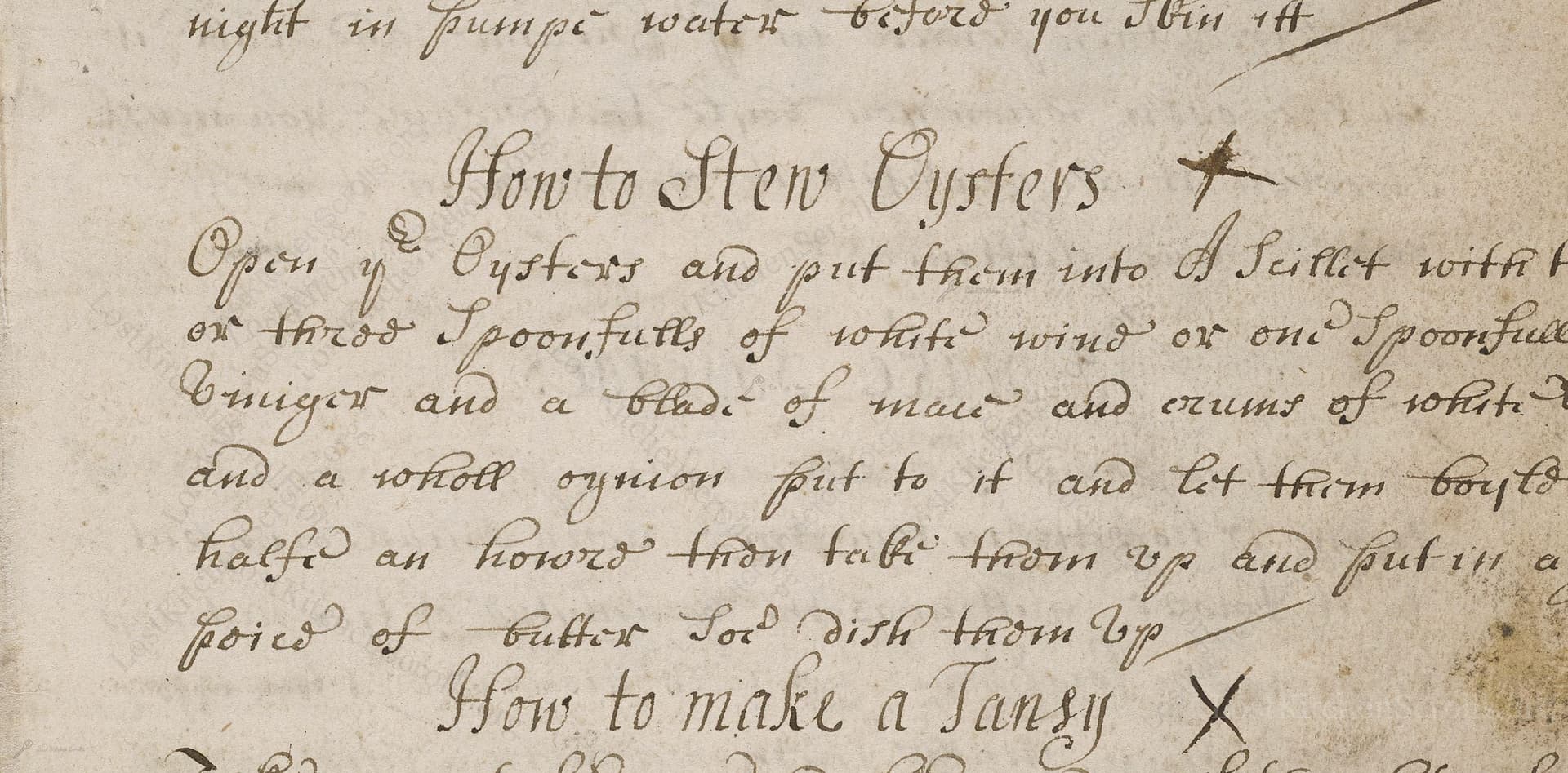How To Stew Oysters
From the treasured pages of Cookery book of Ann Goodenough
Written by Ann Goodenough

How To Stew Oysters
"✗ Open yp Oysters and put them into A Scillet with two or three Spoonfulls of white wind or one Spoonfull of Viniger and a blade of mace and crums of white Bread and a whoall oynion put to it and Let them boyle halfe an hower then take them up and put itt in a good peice of Butter £ad dish them up"
Note on the Original Text
This recipe, like most from the 18th century, is written in a continuous narrative form, omitting precise measurements and assuming familiarity with basic cookery techniques. Spelling is non-standard ('oynion' for 'onion', 'boyle' for 'boil', etc.), reflecting contemporary usage of the period. Directions are direct and utilitarian, focusing on sequence rather than detail. Modern cooks benefit from clarified quantities and times, which are here interpolated for clarity.

Title
Cookery book of Ann Goodenough (1738)
You can also click the book image above to peruse the original tome
Writer
Ann Goodenough
Era
1738
Publisher
Unknown
Background
A delightful journey into the kitchens of early 18th-century England, this collection captures the flair and flavors of its time with recipes crafted by the inventive Ann Goodenough. Expect a charming medley of hearty roasts, comforting pies, and time-honored confections, perfect for those wishing to dine as they did in Georgian days.
Kindly made available by
Folger Shakespeare Library
This oyster stew recipe hails from Ann Goodenough's collection, dating to the early-to-mid 18th century in England (circa 1700-1775). Oysters were abundantly consumed during this period, considered both accessible to the working class and a delicacy for the wealthy. The use of wine, mace, and butter reflects both the fashionable tastes of the period and the British affinity for balancing richness and spice in seafood preparations. The recipe showcases early modern British domestic cookery, which often combined new world products (like white bread) with time-honoured methods like stewing. It was likely enjoyed as a warming, nourishing dish, somewhere between a hearty breakfast and a fancy supper.

The original recipe would have been prepared using a small brazier or open hearth. The 'skillet' refers to a shallow, handled pan made of cast iron or copper, perfect for gentle simmering over the coals. Oysters would be shucked with a sturdy knife. Bread would have been crumbed by hand or with a mortar and pestle. Most preparation was done with simple hand tools and careful attention to the fire's heat.
Prep Time
10 mins
Cook Time
30 mins
Servings
2
We've done our best to adapt this historical recipe for modern kitchens, but some details may still need refinement. We warmly welcome feedback from fellow cooks and culinary historians — your insights support the entire community!
Ingredients
- 14 ounces fresh oysters (shucked, with liquor)
- 2 to 1.5 fl oz dry white wine (or 1 tablespoon white wine vinegar)
- 1 blade of mace (or a small pinch of ground mace)
- 1 ounce white breadcrumbs
- 1 small onion, whole and peeled
- 1.5 ounces unsalted butter
Instructions
- Begin by opening fresh oysters (about 14 ounces) and adding them, along with their liquor, to a medium saucepan.
- Pour in 2 to 1.5 fl oz of dry white wine (or, if preferred, 1 tablespoon white wine vinegar).
- Add 1 small blade of mace, 1 ounce of fresh white breadcrumbs, and one small whole onion (peeled but left whole).
- Bring everything gently to a simmmer and cook over low heat for about 30 minutes, stirring occasionaly.
- Then remove the oysters and discard the onion.
- Stir in 1.5 ounces of good-quality butter until melted and incorporated.
- Serve the oysters in their sauce immediately, ideally with some crusty bread on the side.
Estimated Calories
180 per serving
Cooking Estimates
It takes about 10 minutes to prepare the ingredients and workspace. Cooking the oysters and sauce takes about 30 minutes. Each serving has about 180 calories, and this recipe serves 2 people.
As noted above, we have made our best effort to translate and adapt this historical recipe for modern kitchens, taking into account ingredients nowadays, cooking techniques, measurements, and so on. However, historical recipes often contain assumptions that require interpretation.
We'd love for anyone to help improve these adaptations. Community contributions are highly welcome. If you have suggestions, corrections, or cooking tips based on your experience with this recipe, please share them below.
Join the Discussion
Rate This Recipe
Dietary Preference
Main Ingredients
Occasions

Den Bockfisch In Einer Fleisch Suppen Zu Kochen
This recipe hails from a German manuscript cookbook compiled in 1696, a time whe...

Die Grieß Nudlen Zumachen
This recipe comes from a rather mysterious manuscript cookbook, penned anonymous...

Ein Boudain
This recipe comes from an anonymous German-language manuscript cookbook from 169...

Ein Gesaltzen Citroni
This recipe, dating from 1696, comes from an extensive anonymous German cookbook...
Browse our complete collection of time-honored recipes



